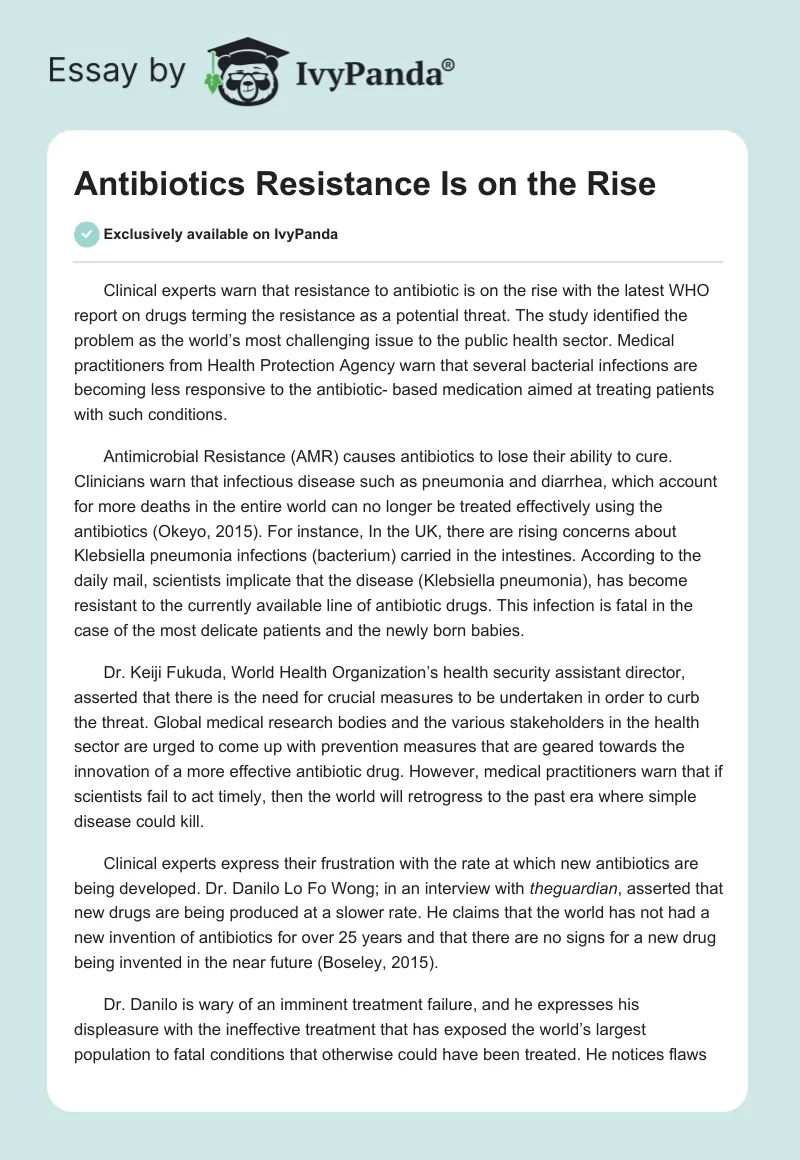Clinical experts warn that resistance to antibiotic is on the rise with the latest WHO report on drugs terming the resistance as a potential threat. The study identified the problem as the world’s most challenging issue to the public health sector. Medical practitioners from Health Protection Agency warn that several bacterial infections are becoming less responsive to the antibiotic- based medication aimed at treating patients with such conditions.
Antimicrobial Resistance (AMR) causes antibiotics to lose their ability to cure. Clinicians warn that infectious disease such as pneumonia and diarrhea, which account for more deaths in the entire world can no longer be treated effectively using the antibiotics (Okeyo, 2015). For instance, In the UK, there are rising concerns about Klebsiella pneumonia infections (bacterium) carried in the intestines. According to the daily mail, scientists implicate that the disease (Klebsiella pneumonia), has become resistant to the currently available line of antibiotic drugs. This infection is fatal in the case of the most delicate patients and the newly born babies.
Dr. Keiji Fukuda, World Health Organization’s health security assistant director, asserted that there is the need for crucial measures to be undertaken in order to curb the threat. Global medical research bodies and the various stakeholders in the health sector are urged to come up with prevention measures that are geared towards the innovation of a more effective antibiotic drug. However, medical practitioners warn that if scientists fail to act timely, then the world will retrogress to the past era where simple disease could kill.
Clinical experts express their frustration with the rate at which new antibiotics are being developed. Dr. Danilo Lo Fo Wong; in an interview with theguardian, asserted that new drugs are being produced at a slower rate. He claims that the world has not had a new invention of antibiotics for over 25 years and that there are no signs for a new drug being invented in the near future (Boseley, 2015).
Dr. Danilo is wary of an imminent treatment failure, and he expresses his displeasure with the ineffective treatment that has exposed the world’s largest population to fatal conditions that otherwise could have been treated. He notices flaws in the medical practice that could render patients more susceptible to the bacterial infection due to antibiotic resistance.
A section of human right activists criticizes some of the methodologies adopted by hospitals when procuring treatment. For instance, they cite a case whereby the patients are treated with the same kind of antibiotics for a long time. This faction of human right activist lobbies for a rather precise method to be adopted instead of the ‘test and trial’ approach. The latter perspective entails treating the patient with different kinds of antibiotic in an effort of determine the one that will work well. Health practitioners point out that such approach is totally outrageous as it exposes the patients to more danger arising from the increased resistance.
Latest health research indicated that some of the European nations retract from carrying out a substantial test to establish the condition before any infection is treated, especially if the hospital will incur additional costs in the process. A global report has revealed that an estimated 10 million lives can be claimed yearly due to antibiotic resistance. The same report indicates that the situation can cost the world’s economy an accumulated figure of 64 trillion pounds for the next 35 years.
Medical personnel argue that some of the patients fail to take the full dosage due to ignorance; a case that will aggravate the patient’s susceptibility due to the overall resistance in the long run. Certain individuals buy antibiotic drugs over the counter in spite of the fact that they have not been tested to ascertain the condition they are suffering from. Such individuals rely on the flimsy reason that they have once suffered from the condition.
Clinicians warn that the conditions that one suffers from might have mimicked the signs associated with a particular disease yet it is a different ailment. Other patients would prefer to acquire the drugs in the pharmaceutical shops only because accessing a qualified physician will involve paying some consultation fees. This practice can be very expensive at times if the process will involve conducting lab test. WHO report raises concerns about the above observations. It has caused a lot of challenges as far as the efforts to treat and contain TB are concerned.
Anti-TB drug resistance is on the rise, and it has caused concerns throughout the world. In the same report, the WHO advocated that all countries adopt a less use of antibiotics when treating patients. In the UK, for instance, antibiotics have been used for a long time to treat superbugs- the form of bacterial infection that causes significant resistance to antibiotics. Medical practitioners in the UK are urged to observe hygienic conditions. Clinicians should encourage their patients to embrace proper hand hygiene. This measure is deemed adequate for handling Staphylococcus aureus, the ‘superbug’ that has shown antibiotic-resistant to the drug methicillin. Meanwhile, gonorrhea, which is sexually transmitted, is getting immunity to the last-resort injection used for its treatment.
References
Boseley, S. (2015). WHO Calls for Urgent Action to Preserve Power of Antibiotics and Make New Ones.Theguardian. Web.
Okeyo, v. (2015). Alarm as Antibiotics Lose Power to Cure. Daily Nation. Web.


